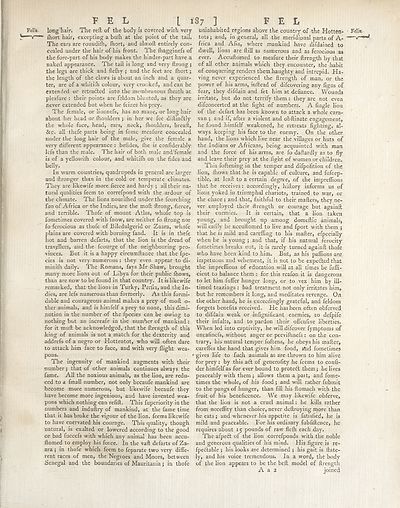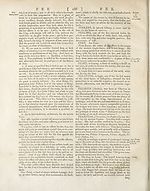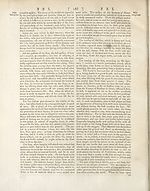Encyclopaedia Britannica > Volume 7, ETM-GOA
(205) Page 187 - FEL
Download files
Complete book:
Individual page:
Thumbnail gallery: Grid view | List view

F E L l 187 ] F E L
Fells, long hair. The reft of the body 1$ covered with very
fhort hair, excepting a bufti at the point of the tail.
The ears are roundiih, Ihort, and almoft entirely con¬
cealed under the hair of his front. The ftiagginefs of
the fore-part of his body makes the hinder-part have a
naked appearance. The tail is long and very ftrong ;
the legs are thick and flefliy ; and the feet are ftiort;
the length of the claws is about an inch and a quar¬
ter, are of a whitifti colour, very crooked, and can be
extended or retraced into the membranous fheath at
pleafure : their points are feldom blunted, as they are
never extended but when he feizes his prey.
The female, or lionnefs, has no mane, or long hair
about her head or (houlders ; in her we fee diltinCtly
the whole face,, head, ears, neck, ftioulders, breaft,
&c. all thefe parts being in fome meafure concealed
under the long hair of the male, give the female a
very different appearance : belides, fhe is confiderably
lefs than the male. The hair of both male and'female
is of a yellovvilh colour, and whitifti on the Tides and
belly.
In warm countries, quadrupeds in general are larger
and ftronger than in the cold or temperate climates.
They are likewife more fierce and hardy ; all their na¬
tural qualities feem to correfpond with the ardour of
the climate. The lions nouriflied under the fcorching
fun of Africa or the Indies, are the moft ftrong, fierce,
and terrible. Thofe of mount Atlas, whofe top is
fometimes covered with fnow, are neither fo ftrong nor
fo ferocious as thofe of Biledulgerid or Zaara, whofe
plains are covered with burning fand. It is in thefe
hot and barren defarts, that the lion is the dread of
travellers, and the fcourge of the neighbouring pro¬
vinces. But it is a happy circumftance that the fpe-
cies is not very numerous: they even appear to di-
minifli daily. The Romans, fays Mr Shaw, brought
many more lions out of Libya for their public ftiows,
than are now to be found in that country. Itislikewife
remarked, that the lions in Turky, Perfia, and the In¬
dies, are lefs numerous than formerly. As this formi¬
dable and courageous animal makes a prey of moft o-
ther animals, and is himfelf a prey to none, this dimi¬
nution in the number of the fpecies can be owing to
nothing but an increafe in the number of mankind :
for it muft be acknowledged, that the ftremgth of this
king of animals is not a match for the dexterity and
addrefs of a negro or Hottentot, who will often dare
to attack him face to face, and with very flight wea¬
pons, *
The ingenuity of mankind augments with their
number; that of other animals continues always the
fame. All the noxious animals, as the lion, are redu¬
ced to a fmall number, not only becaufe mankind are
become more numerous, but likewife becaufe they
have become more ingenious, and have invented wea¬
pons which nothing can refill. This fuperiority in the
numbers and induftry of mankind, at the fame time
that it has broke the vigour of the lion, feems likewife
to have enervated his courage. This quality, though
natural, is exalted or lowered according to the good
or bad fuccefs with which any animal has been accu-
ftomed to employ his force. In the vaft defarts of Za¬
ara ; in thofe which feem to feparate two very diffe¬
rent races of men, the Negroes and Moors, between
Senegal and the boundaries of Mauritania; in thofe
uninhabited regions above the country of the Hotten- Fells.
tots; and, in general, all the meridional parts of A-
frica and Afia, where mankind have difdained to
dwell, lions are Hill as numerous and as ferocious as
ever. Accuftomed to meafure their ftrength by that
of all other animals which they encounter, the habit
of conquering renders them haughty and intrepid. Ha¬
ving never experienced the ftrength of man, or the
power of his arms, inftead of difeovering any figns of
fear, they difdain and fet him at defiance. Wounds
irritate, but do not terrify them: they are not even
difconcerted at the fight of numbers. A fingle lion
of the defart has been known to attack a whole cara¬
van ; and if, after a violent and obftinate engagement,
he found himfelf weakened, he retreats fighting, al¬
ways keeping his face to the enemy. On the other
hand, the lions which live near the villages or huts of
the Indians or Africans, being acquainted with man
and the force of his arms, are fo daftardly as to fly
and leave their prey at the fight of women or children.
This foftening in the temper and difpofition of the
lion, Ihows that he is capable of culture, and fufeep-
tible, at leaft to a certain degree, of ihe impreflions
that he receives: accordingly, hiftory informs us of
lions yoked in triumphal chariots, trained to war, or
the chace ; and that, faithful to their mafters, they ne¬
ver employed their ftrength or courage but againft
their enemies. It is certain, that a lion taken
young, and brought up among domeftic animals,
will eaiily be accuftomed to live and fport with them ;
that he is mild and carefling to his mafter, efpecially
when he is young ; and that, if his natural ferocity
fometimes breaks out, it is rarely turned againft thofe
who have been kind to him. But, as his paflions are
impetuous and vehement, it is not to be expe&ed that
the imprefiions of education will at all times be fuffi-
cient to balance them : for this reafon it is dangerous
to let him fuffer hunger long, or to vex him by ill-
timed teazings : bad treatment not only irritates him,
but he remembers it long, and meditates revenge. On
the other hand, he is exceedingly grateful, and feldom
forgets benefits received. He has been often obferved
to difdain weak or infignificant enemies, to defpife
their infults, and to pardon their offenfive liberties.
When led into captivity, he will difeover fymptoms of
uneafinefs, without anger or peeviftmefs : on the con¬
trary, his natural temper foftens, he obeys his mafter,
careffes the hand that gives him food, sftid fometimes
gives life to fuch animals as are thrown to him alive
for prey: by this a6l of generofity he feems to confi-
der himfelf as for ever bound to protedl them; he lives
peaceably with them ; allows them a part, and fome¬
times the whole, of his food; and will rather fubmit
to the pangs of hunger, than fill his ftomach with the
fruit of his beneficence. We may likewife obferve,
that the lion is not a cruel animal: he kills rather
from neceflity than choice, never deftroying more than
he eats; and whenever his appetite is fatisfied, he is
mild and peaceable. For his ordinary fubfiftence, he
requires about 15 pounds of raw flefti each day.
The afpeCt of the lion correfponds with the noble
and generous qualities of his mind. His figure is re-
fpe&able ; his looks are determined ; his gait is ftate-
ly, and his voice tremendous. In a word, the body
of the lion appears to be the bell model of ftrength
A a 2 joined
Fells, long hair. The reft of the body 1$ covered with very
fhort hair, excepting a bufti at the point of the tail.
The ears are roundiih, Ihort, and almoft entirely con¬
cealed under the hair of his front. The ftiagginefs of
the fore-part of his body makes the hinder-part have a
naked appearance. The tail is long and very ftrong ;
the legs are thick and flefliy ; and the feet are ftiort;
the length of the claws is about an inch and a quar¬
ter, are of a whitifti colour, very crooked, and can be
extended or retraced into the membranous fheath at
pleafure : their points are feldom blunted, as they are
never extended but when he feizes his prey.
The female, or lionnefs, has no mane, or long hair
about her head or (houlders ; in her we fee diltinCtly
the whole face,, head, ears, neck, ftioulders, breaft,
&c. all thefe parts being in fome meafure concealed
under the long hair of the male, give the female a
very different appearance : belides, fhe is confiderably
lefs than the male. The hair of both male and'female
is of a yellovvilh colour, and whitifti on the Tides and
belly.
In warm countries, quadrupeds in general are larger
and ftronger than in the cold or temperate climates.
They are likewife more fierce and hardy ; all their na¬
tural qualities feem to correfpond with the ardour of
the climate. The lions nouriflied under the fcorching
fun of Africa or the Indies, are the moft ftrong, fierce,
and terrible. Thofe of mount Atlas, whofe top is
fometimes covered with fnow, are neither fo ftrong nor
fo ferocious as thofe of Biledulgerid or Zaara, whofe
plains are covered with burning fand. It is in thefe
hot and barren defarts, that the lion is the dread of
travellers, and the fcourge of the neighbouring pro¬
vinces. But it is a happy circumftance that the fpe-
cies is not very numerous: they even appear to di-
minifli daily. The Romans, fays Mr Shaw, brought
many more lions out of Libya for their public ftiows,
than are now to be found in that country. Itislikewife
remarked, that the lions in Turky, Perfia, and the In¬
dies, are lefs numerous than formerly. As this formi¬
dable and courageous animal makes a prey of moft o-
ther animals, and is himfelf a prey to none, this dimi¬
nution in the number of the fpecies can be owing to
nothing but an increafe in the number of mankind :
for it muft be acknowledged, that the ftremgth of this
king of animals is not a match for the dexterity and
addrefs of a negro or Hottentot, who will often dare
to attack him face to face, and with very flight wea¬
pons, *
The ingenuity of mankind augments with their
number; that of other animals continues always the
fame. All the noxious animals, as the lion, are redu¬
ced to a fmall number, not only becaufe mankind are
become more numerous, but likewife becaufe they
have become more ingenious, and have invented wea¬
pons which nothing can refill. This fuperiority in the
numbers and induftry of mankind, at the fame time
that it has broke the vigour of the lion, feems likewife
to have enervated his courage. This quality, though
natural, is exalted or lowered according to the good
or bad fuccefs with which any animal has been accu-
ftomed to employ his force. In the vaft defarts of Za¬
ara ; in thofe which feem to feparate two very diffe¬
rent races of men, the Negroes and Moors, between
Senegal and the boundaries of Mauritania; in thofe
uninhabited regions above the country of the Hotten- Fells.
tots; and, in general, all the meridional parts of A-
frica and Afia, where mankind have difdained to
dwell, lions are Hill as numerous and as ferocious as
ever. Accuftomed to meafure their ftrength by that
of all other animals which they encounter, the habit
of conquering renders them haughty and intrepid. Ha¬
ving never experienced the ftrength of man, or the
power of his arms, inftead of difeovering any figns of
fear, they difdain and fet him at defiance. Wounds
irritate, but do not terrify them: they are not even
difconcerted at the fight of numbers. A fingle lion
of the defart has been known to attack a whole cara¬
van ; and if, after a violent and obftinate engagement,
he found himfelf weakened, he retreats fighting, al¬
ways keeping his face to the enemy. On the other
hand, the lions which live near the villages or huts of
the Indians or Africans, being acquainted with man
and the force of his arms, are fo daftardly as to fly
and leave their prey at the fight of women or children.
This foftening in the temper and difpofition of the
lion, Ihows that he is capable of culture, and fufeep-
tible, at leaft to a certain degree, of ihe impreflions
that he receives: accordingly, hiftory informs us of
lions yoked in triumphal chariots, trained to war, or
the chace ; and that, faithful to their mafters, they ne¬
ver employed their ftrength or courage but againft
their enemies. It is certain, that a lion taken
young, and brought up among domeftic animals,
will eaiily be accuftomed to live and fport with them ;
that he is mild and carefling to his mafter, efpecially
when he is young ; and that, if his natural ferocity
fometimes breaks out, it is rarely turned againft thofe
who have been kind to him. But, as his paflions are
impetuous and vehement, it is not to be expe&ed that
the imprefiions of education will at all times be fuffi-
cient to balance them : for this reafon it is dangerous
to let him fuffer hunger long, or to vex him by ill-
timed teazings : bad treatment not only irritates him,
but he remembers it long, and meditates revenge. On
the other hand, he is exceedingly grateful, and feldom
forgets benefits received. He has been often obferved
to difdain weak or infignificant enemies, to defpife
their infults, and to pardon their offenfive liberties.
When led into captivity, he will difeover fymptoms of
uneafinefs, without anger or peeviftmefs : on the con¬
trary, his natural temper foftens, he obeys his mafter,
careffes the hand that gives him food, sftid fometimes
gives life to fuch animals as are thrown to him alive
for prey: by this a6l of generofity he feems to confi-
der himfelf as for ever bound to protedl them; he lives
peaceably with them ; allows them a part, and fome¬
times the whole, of his food; and will rather fubmit
to the pangs of hunger, than fill his ftomach with the
fruit of his beneficence. We may likewife obferve,
that the lion is not a cruel animal: he kills rather
from neceflity than choice, never deftroying more than
he eats; and whenever his appetite is fatisfied, he is
mild and peaceable. For his ordinary fubfiftence, he
requires about 15 pounds of raw flefti each day.
The afpeCt of the lion correfponds with the noble
and generous qualities of his mind. His figure is re-
fpe&able ; his looks are determined ; his gait is ftate-
ly, and his voice tremendous. In a word, the body
of the lion appears to be the bell model of ftrength
A a 2 joined
Set display mode to:
![]() Universal Viewer |
Universal Viewer | ![]() Mirador |
Large image | Transcription
Mirador |
Large image | Transcription
Images and transcriptions on this page, including medium image downloads, may be used under the Creative Commons Attribution 4.0 International Licence unless otherwise stated. ![]()
| Encyclopaedia Britannica > Encyclopaedia Britannica > Volume 7, ETM-GOA > (205) Page 187 - FEL |
|---|
| Permanent URL | https://digital.nls.uk/189123894 |
|---|
| Attribution and copyright: |
|
|---|
| Description | Ten editions of 'Encyclopaedia Britannica', issued from 1768-1903, in 231 volumes. Originally issued in 100 weekly parts (3 volumes) between 1768 and 1771 by publishers: Colin Macfarquhar and Andrew Bell (Edinburgh); editor: William Smellie: engraver: Andrew Bell. Expanded editions in the 19th century featured more volumes and contributions from leading experts in their fields. Managed and published in Edinburgh up to the 9th edition (25 volumes, from 1875-1889); the 10th edition (1902-1903) re-issued the 9th edition, with 11 supplementary volumes. |
|---|---|
| Additional NLS resources: |
|

